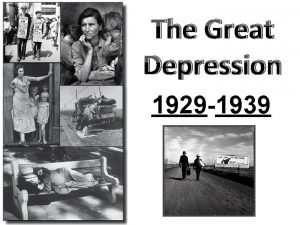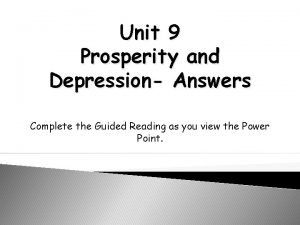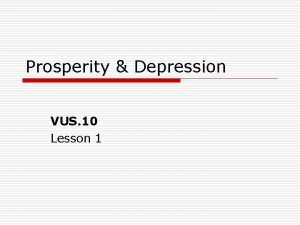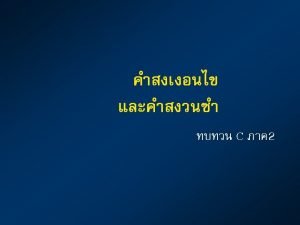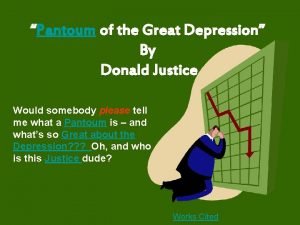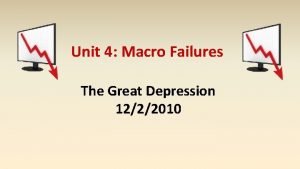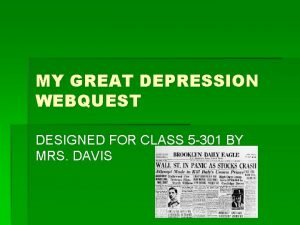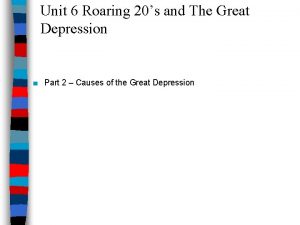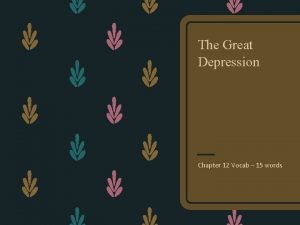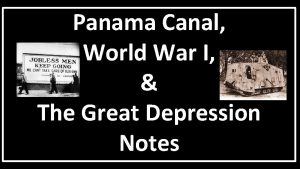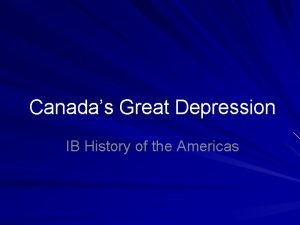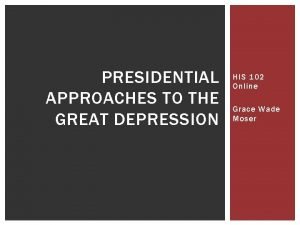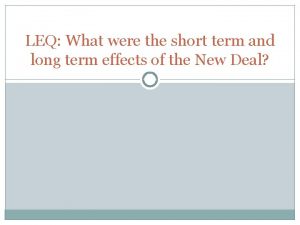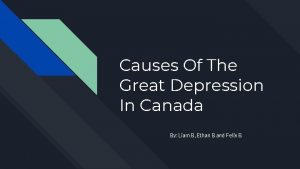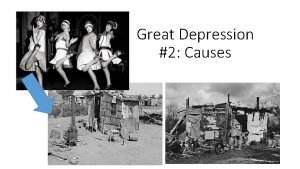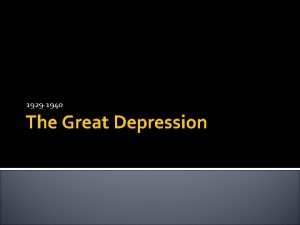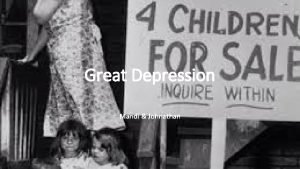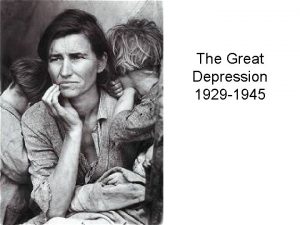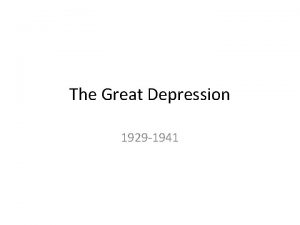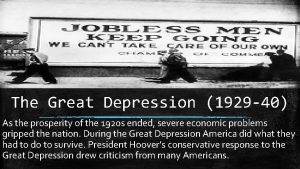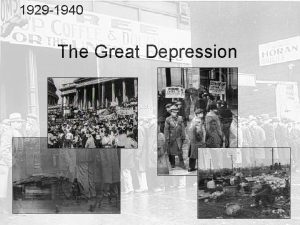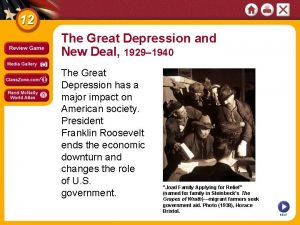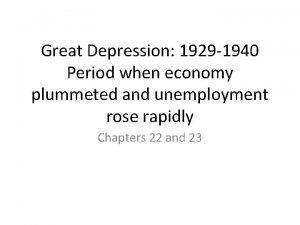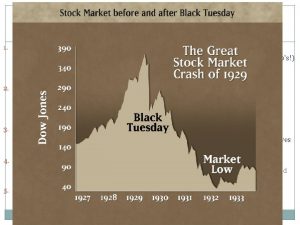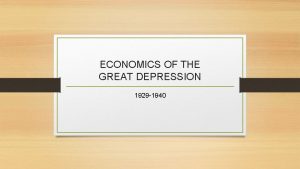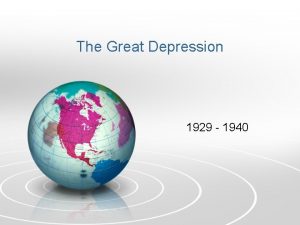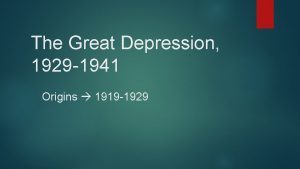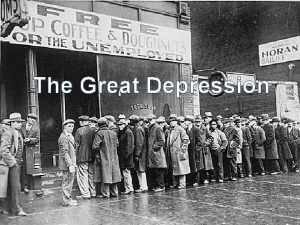THE GREAT DEPRESSION 1929 1940 False Prosperity of




















- Slides: 20

THE GREAT DEPRESSION 1929 -1940

False Prosperity of the 1920’s n n n n Industrial production Increased wealth New businesses & products Low unemployment New investment opportunity (Stock Market) Little gov’t. interference Everything looked ok, but underneath the surface major economic problems are present.

Causes Ø Ø 1. Overproduction and underconsumption Ø In the late 1920 s, factories and farmers produced more than they could sell. 2. Inequality of wealth Ø gap between the rich and the poor Ø Top 1% of people got 75% of all new wealth created (rich were getting richer) 3. Stock Market – Ø People invest too much in hopes to “get rich quick” Ø Purchase stocks with borrowed money or do not pay full price = buying on margin = artificially high prices Ø No gov’t regulation 4. Shaky Banking – Ø Gov’t did not regulate banks Ø Everyone is overusing credit. $ is not insured. Ø Banks have invested in the stock market

Stock Market Crash n n n People started to sell their stocks October 29 th 1929: “Black Tuesday” the market crashed! q People could not repay loans and led to many bank failures q Millions lost life savings q Prices fell, and factories closed, workers lost jobs People are concerned that their banks invested in the market q People rush to banks to withdraw their savings q Bank Run

Unemployment Rate: 1929 -1943

Problems of the Great Depression n 25% Unemployment Businesses are not making money and are closing The economy is completely unregulated

What Does President Hoover (R) Do? n n n Talks confidently Cut taxes Increase gov’t spending on federal projects Volunteerism – Hoover meets with leaders of business, labor and agriculture and asks them to maintain wages and production “Rugged Individualism” q q Personal responsibility Work your way out of G. D.

Hoover is Unpopular n n Shanty towns of the homeless and unemployed were called “Hoovervilles” Bonus Army – veterans marched in D. C. in 1932 to demand their bonus for fighting in WWI. Hoover calls army out

BONUS ARMY



The Dust Bowl: 1931 1939

Dust Storms: "Dust Storm Near Beaver, Oklahoma. " (July 14, 1935)

The Dust Bowl n n Droughts in the early 1930 s dried up crops and topsoil, turning soil into dust. Over 1 mill farmers were driven from their lands. q Many leave to become migrant workers in Cali – “Okies” n John Steinbeck – The Grapes of Wrath Unemployed men leave families to find work and not be a drain Some families expand to include extremely poor or needy relatives

Election of 1932 n n n Hoover (R) v. Franklin Delano Roosevelt (D) FDR wins by a landslide. Believed: q q n federal government should be the one to fix the problems of the depression. It is a National problem, not an international problem Roosevelt promised Americans a “New Deal” to put them back to work.


Eleanor Roosevelt n Humanitarian q n Traveled extensively q n Especially for women and minorities Husband’s eyes and ears Would travel and talk to those struggling q Reports influenced New Deal programs

Building Confidence n n n Brain Trust – group of talented people who served FDR in cabinet or gov’t Fireside Chats – FDR spoke to the people using the radio, his cheerful optimism helped to restore public confidence. Hundred Days – period in 1933 when FDR pushes programs through Congress

Bank Holiday n n March 5 -9, 1933 Emergency Banking Act q q q n All banks closed Gov’t inspects every bank’s financial health 2/3 rds of banks are deemed strong enough to reopen Restores some confidence in banks q People deposit money – banks can loan it out

FDR’s 3 Pronged Attack on the Great Depression n FDR passed laws – 3 R’s – Relief, Recovery and Reform q q q Relief – provides jobs to unemployed Recovery – government spending to put money back in the economy Reform – changes in laws to fix and prevent another depression
 Great depression 1929
Great depression 1929 Stock market crash 1929 political cartoons
Stock market crash 1929 political cartoons Prosperity and depression worksheet answers
Prosperity and depression worksheet answers Prosperity and depression worksheet answers
Prosperity and depression worksheet answers Black tuesday political cartoon
Black tuesday political cartoon Slidetodoc
Slidetodoc True or false true or false
True or false true or false Donald justice pantoum of the great depression
Donald justice pantoum of the great depression Great depression
Great depression Great depression webquest
Great depression webquest Hoovervilles great depression
Hoovervilles great depression Great depression
Great depression Great depression vocabulary words
Great depression vocabulary words What was the great depression
What was the great depression Birth rate during the great depression
Birth rate during the great depression Great depression photographer
Great depression photographer Hoovers poor farm tobacco fund
Hoovers poor farm tobacco fund The great depression leq
The great depression leq Great depression
Great depression Great depression jeopardy
Great depression jeopardy Hoovervilles great depression
Hoovervilles great depression
